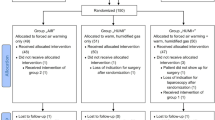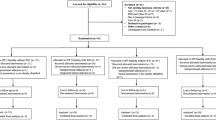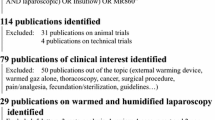Abstract
Postoperative pain is related to the gas used for laparoscopy as demonstrated for 100 % nitrous oxide in 2002 by Tsereteli. In a previous trial, we demonstrated that the use of full conditioning adding 10 % nitrous oxide and 4 % oxygen to the CO2 pneumoperitoneum with humidification and altering the temperature of the insufflation gas, the use of Hyalobarrier gel, and the administration of 5 mg dexamethasone significantly reduced postoperative pain and decreased adhesions. As we believed that just altering the insufflation gas by adding 10 % of nitrous oxide and 4 % of oxygen would reduce pain and adhesions by itself, we performed a randomized controlled trial on women undergoing robot-assisted laparoscopic myomectomy. Fourteen women undergoing robot-assisted laparoscopic myomectomy were randomized 1:1 receiving 86 % CO2 + 10 % N2O + 4 % O2 or 100 % CO2. Outcome parameters were postoperative pain (visual analog scale (VAS)) and adhesions observed at second-look laparoscopy after 14 days. Pain and painkiller intake were significantly reduced by using the altered insufflation gas (p < 0.05). Adhesions did not show a significant difference, although the study group tended to have less adhesions (p < 0.21). Addition of 10 % N2O and 4 % O2 to the pneumoperitoneum significantly decreased postoperative pain, even in a low number of participants, which suggests a strong effect.




Similar content being viewed by others
References
Mais V (2014) Peritoneal adhesions after laparoscopic gastrointestinal surgery. World J Gastroenterol 20(17):4917–4925
ten Broek RP, Issa Y, van Santbrink EJ, Bouvy ND, Kruitwagen RF, Jeekel J, Bakkum EA, Rovers MM, van Goor H (2013) Burden of adhesions in abdominal and pelvic surgery: systematic review and met-analysis. BMJ 347:f5588
Ellis H, Moran BJ, Thompson JN, Parker MC, Wilson MS, Menzies D, McGuire A, Lower AM, Hawthorn RJ, O’Brien F, Buchan S, Crowe AM (1999) Adhesion-related hospital readmissions after abdominal and pelvic surgery: a retrospective cohort study. Lancet 353:1476–1480
Monk BJ, Berman ML, Montz FJ (1994) Adhesions after extensive gynecologic surgery: clinical significance, etiology, and prevention. Am J Obstet Gynecol 170:1396–1403
Lower AM, Hawthorn RJ, Ellis H, O’Brien F, Buchan S, Crowe AM (2000) The impact of adhesions on hospital readmissions over ten years after 8849 open gynaecological operations: an assessment from the Surgical and Clinical Adhesions Research Study. BJOG 107:855–862
Coleman MG, McLAin AD, Moran BJ (2000) Impact of previous surgery on time taken for incision and division of adhesions during laparotomy. Dis Colon Rectum 43:1297–1299
Corona R, Verguts J, Schonman R, Binda MM, Mailova K, Koninckx PR (2011) Postoperative inflammation in the abdominal cavity increases adhesion formation in a laparoscopic mouse model. Fertil Steril 95:1224–1228
Molinas CR, Mynbaev O, Pauwels A, Novak P, Konickx PR (2001) Peritoneal mesothelial hypoxia during pneumoperitoneum is a cofactor in adhesion formation in a laparoscopic mouse model. Fertil Steril 76:560–567
Molinas CR, Tjwa M, Vanacker B, Binda MM, Elkelani O, Koninckx PR (2004) Role of CO2 pneumoperitoneum-induced acidosis in CO2 pneumoperitoneum-enhanced adhesion formation in mice. Fertil Steril 81:708–711
Elkelani OA, Binda MM, Molinas CR, Koninckx PR (2004) Effect of adding more than 3 % oxygen to carbon dioxide pneumoperitoneum on adhesion formation in a laparoscopic mouse model. Fertil Steril 82:1616–1622
Binda MM, Molinas CR, Mailova K, Koninckx PR (2004) Effect of temperature upon adhesion formation in a laparoscopic mouse model. Hum Reprod 19:2626–2632
Binda MM, Molinas CR, Hansen P, Koninckx PR (2006) Effect of desiccation and temperature during laparoscopy on adhesion formation in mice. Fertil Steril 86:166–175
Corona R, Verguts J, Koninckx R, Mailova K, Binda MM, Koninckx PR (2011) Intraperitoneal temperature and desiccation during endoscopic surgery. Intraoperative humidification and cooling of the peritoneal cavity can reduce adhesions. Am J Obstet Gynecol 205:392 e1-7
Corona R, Binda MM, Mailova K, Verguts J, Koninckx PR (2013) Addition of nitrous oxide to the carbon dioxide pneumoperitoneum strongly decreases adhesion formation and the dose-dependent adhesiogenic effect of blood in a laparoscopic mouse model. Fertil Steril 100:1777–1178
Koninckx PR, Corona R, Timmerman D, Verguts J, Adamyan L (2013) Peritoneal full-conditioning reduces postoperative adhesions and pain: a randomized controlled trial in deep endometriosis surgery. J Ovarian Res 6:90. doi:10.1186/1757-2215-6-90
Tsereteli Z, Terry ML, Bowers SP, Spivak H, Archer SB, Galloway KD, et al. (2002) Prospective randomized clinical trial comparing nitrous oxide and carbon dioxide pneumoperitoneum for laparoscopic surgery. J Am Coll Surg 195:173–179
Gunatilake DE (1978) Case report: fatal intraperitoneal explosion during electrocoagulation via laparoscopy. Int J Gynecol Obstet 15:353–357
Mynbaev OA, Biro P, Eliseeva MY, Tinelli A, Malvasi A, Kosmas IP, Medvediev MV, Babenko TI, Mazitova MI, Simakov SS, Stark M, Koninckx PR, Corona R, Timmerman D, Verguts J, Adamyan L (2014) A surgical polypragmasy: Peritoneal full-conditioning reduces postoperative adhesions and pain: a randomized controlled trial in deep endometriosis surgery. J Ovarian Res 7:29. doi:10.1186/1757-2215-7-29
Munro MG, Critchley HO, Broder MS, Fraser IS (2011) FIGO classification system (PALM-COEIN) for causes of abnormal uterine bleeding in nongravid women of reproductive age. Int J Gynaecol Obstet 113:3–13
Trew G, Pistofidis G, Pados G, Lower A, Mettler L, Wallwiener D, Korell M, Pouly JL, Coccia ME, Audebert A, Nappi C, Schmidt E, McVeigh E, Landi S, Degueldre M, Konincxk P, Rimbach S, Chapron C, Dallay D, Röemer T, McConnachie A, Ford I, Crowe A, Knight A, Dizerega G, Dewilde R (2011) Gynaecological endoscopic evaluation of 4 % icodextrin solution: a European, multicenter, double-blind, randomized study of the efficacy and safety in the reduction of de novo adhesions after laparoscopic gynaecological surgery. Hum Reprod 26:2015–2027
Mailova K, Osipova AA, Corona R, Binda MM, Koninckx PR, Adamian LV (2012) Intra-operative bleeding: adhesion formation and methods of their prevention in mice. Russian J Hum Reprod 2:18–22
Binda MM, Corona R, Verguts J, Koninckx PR (2011) Peritoneal infusion with cold saline decreased postoperative intra-abdominal adhesion formation. World J Surg 35:242
Binda MM, Koninckx PR (2009) Prevention of adhesion formation in laparoscopic mouse model should combine local treatment with peritoneal cavity conditioning. Hum Reprod 24:1473–1479
El-Kady AA, Abd-Elrazek M (1976) Intraperitoneal explosion during female sterilization by laparoscopic electrocoagulation. Int J Gynecol Obstet 14:487–488
El-Minawi MF, Wahbi O, El-Bagouri IS, Sharawi M, El-Mallah SY (1981) Physiologic changes during CO2 and N2O pneumoperitoneum in diagnostic laparoscopy. A comparative study. J Reprod Med 26(7):338–346
Rademaker BM, Odoom JA, de wit LT, Kalkman CJ, ten Brink SA, Ringers J (1994) Haemodynamic effects of pneumoperitoneum for laparoscopic surgery: a comparison of CO2 with N2O insufflation. Eur J Anaesthesiol 11(4):301–306
Hunter JG, Swanstrom L, Thornburg K (1995) Carbon dioxide pneumoperitoneum induces fetal acidosis in a pregnant ewe model. Surg Endosc. 9(3):272–277
Schöb OM, Allen DC, Benzel E, Curet MJ, Adams MS, Baldwin NG, Largiader F, Zucker KA (1996) A comparison of the pathophysiologic effects of carbon dioxide, nitrous oxide, and helium pneumoperitoneum on intracranial pressure. Am J Surg 172(3):248–253
Sund Kristensen H, Berthelsen PG (1994) Risus sardonicus and laughing gas–when nitrous oxide lost its innocence. Acta Anaesthesiol Scand. 38(8):751–752
Weimann J (2003) Toxicity of nitrous oxide. Best Pract Res Clin Anaesthesiol 17(1):47–61
Koblin DD (1990) Nitrous oxide: a cause of cancer or chemotherapeutic adjuvant? Semin Surg Oncol 6(3):141–147
Verguts J, Vergote I, Amant F, Moerman P, Koninckx P (2008) The addition of 4 % oxygen to the CO2 pneumoperitoneum does not decrease dramatically port site metastases. J Minim Invasive Gynecol 15(6):700–703
Harris ES, Morgan RF, Rodeheaver GT (1995) Analysis of the kinetics of peritoneal adhesion formation in the rat and evaluation of potential antiadhesive agents. Surgery 117(6):663–669
Koninckx PR, Verguts J, Corona R, Adamyan L, Brosens I (2015) A mixture of 86 % of CO2, 10 % N2O and 4 % of oxygen permits laparoscopy under local anesthesia: a pilot study. Gynecol Surg 12:57–60
Cervero F (1995) Visceral pain: mechanisms of peripheral and central sensitization. Ann Med 27:235–239
Authors’ contribution
N Storme: data management and manuscript writing
S Pacquée: project development and data collection
M Ampe: data analysis
A Creemers: data analysis
J Verguts: protocol/project development, data collection or management, and manuscript editing
Author information
Authors and Affiliations
Corresponding author
Ethics declarations
Conflict of interest
The authors declare that they have no conflict of interest.
Informed consent
Informed consent was obtained from all patients for being included in the study.
Rights and permissions
About this article
Cite this article
Storme, N., Pacquée, S., Ampe, M. et al. Peritoneal limited conditioning reduces postoperative pain: a randomized controlled trial in robot-assisted laparoscopic myomectomy. Gynecol Surg 13, 139–146 (2016). https://doi.org/10.1007/s10397-016-0941-9
Received:
Accepted:
Published:
Issue Date:
DOI: https://doi.org/10.1007/s10397-016-0941-9




